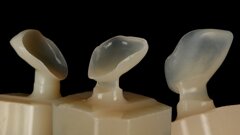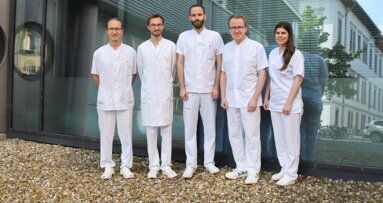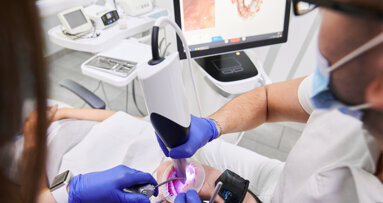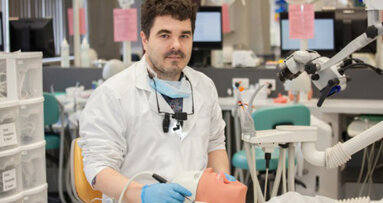WASHINGTON, U.S.: For some patients, no matter how diligent they are with their oral health, issues with their teeth seem to arise more easily than for others. In a new study, scientists have uncovered how a small flaw in a protein results in damaged enamel that is prone to decay. In the study, the researchers found that defective amelogenin proteins stick or bind abnormally tightly to the building enamel, failing to clear out when they should and hindering the growth process through which strong enamel is built.
The condition is known as amelogenesis imperfecta (AI) and those who suffer from it do not develop enamel correctly because of a single amino acid defect in the amelogenin. The genetic defect causes soft, discolored enamel that easily breaks. “The teeth aren’t as strong because the enamel is much thinner and the crystals less ordered,” said first author of the paper Dr. Jinhui Tao, from Pacific Northwest National Laboratory. “In most people, the enamel is the hardest substance in their body, but that’s not true for patients with AI.”
Tao and his colleagues wanted to see how strongly proteins stick to other substances and to each other, a process known as protein binding. In order to see this unfold in real time, the team combined atomic force microscopy with solid-state nuclear magnetic resonance spectroscopy, available through the Environmental Molecular Sciences Laboratory, as well as other methods to study mineralization and other processes involving the proteins that form enamel.
According to the study’s results, the defective proteins’ tendency to stick too long and too strongly to the surface disrupts other molecular players from doing their jobs in creating a solid crystalline structure. They also slow down an enzyme known as matrix metallopeptidase-20 (MMP20),which removes excess amelogenin from the developing mineral surface. When MMP20 cannot do its job, enamel grows more slowly and is weaker. The sticky proteins also slow down the formation of hydroxyapatite.
“This work helps us understand why people with these mutations have weak and fragile tooth enamel, but more broadly, it gives us important information about how to control the creation or manipulation of materials for many applications, such as the development of new organic–inorganic hybrid materials for high-performance computing, catalysis research, or energy storage,” Tao said.
The study, titled “The energetic basis for hydroxyapatite mineralization by amelogenin variants provides insights into the origin of amelogenesis imperfecta,” was published on July 9, 2019, in the Proceedings of the National Academy of Sciences of the United States of America.
Tags:
TAIPEI, Taiwan: The debate on climate change and its effects on the earth are a hot topic. One discussion, in particular, is around air pollution, which is ...
AMMAN, Jordan: As artificial intelligence continues to expand its role in healthcare, large language models such as ChatGPT are increasingly being used to ...
GUANGZHOU, China: While live surgery demonstrations have been a popular and effective educational tool across all facets of the medical field for decades, ...
NEW YORK, US: Oral diseases and depression are both projected to rise in prevalence over the coming decades, and recent findings suggest the two may be ...
SYDNEY, Australia: The underlying causes of central sensitisation disorders such as migraine and fibromyalgia are poorly understood. The gut–brain axis ...
JOHANNESBURG, South Africa: In 2018, South Africa introduced a tax on sugar-sweetened beverages (SSBs) based on their respective levels of sugar content ...
SEOUL, South Korea: Even though intra-oral scanners have been around for more than three decades and their use in dental practice is increasing, few ...
NEW YORK, US: The Oral Health Workforce Research Center (OHWRC) is responsible for providing research on the oral health workforce in the US and assisting ...
DUNEDIN, New Zealand: A new study by researchers at the University of Otago Faculty of Dentistry in Dunedin has shown that the use of mercury in dental ...
Live webinar
Mon. 3 November 2025
12:30 pm EST (New York)
Prof. Dr. Falk Schwendicke MDPH
Live webinar
Tue. 4 November 2025
1:00 pm EST (New York)
Live webinar
Tue. 4 November 2025
8:00 pm EST (New York)
Joy Void-Holmes RDH, BSDH, DHSc
Live webinar
Wed. 5 November 2025
3:30 am EST (New York)
Live webinar
Wed. 5 November 2025
12:00 pm EST (New York)
Live webinar
Wed. 5 November 2025
2:00 pm EST (New York)
Prof. Gianluca Gambarini MD, DDS
Live webinar
Wed. 5 November 2025
8:00 pm EST (New York)



 Austria / Österreich
Austria / Österreich
 Bosnia and Herzegovina / Босна и Херцеговина
Bosnia and Herzegovina / Босна и Херцеговина
 Bulgaria / България
Bulgaria / България
 Croatia / Hrvatska
Croatia / Hrvatska
 Czech Republic & Slovakia / Česká republika & Slovensko
Czech Republic & Slovakia / Česká republika & Slovensko
 France / France
France / France
 Germany / Deutschland
Germany / Deutschland
 Greece / ΕΛΛΑΔΑ
Greece / ΕΛΛΑΔΑ
 Hungary / Hungary
Hungary / Hungary
 Italy / Italia
Italy / Italia
 Netherlands / Nederland
Netherlands / Nederland
 Nordic / Nordic
Nordic / Nordic
 Poland / Polska
Poland / Polska
 Portugal / Portugal
Portugal / Portugal
 Romania & Moldova / România & Moldova
Romania & Moldova / România & Moldova
 Slovenia / Slovenija
Slovenia / Slovenija
 Serbia & Montenegro / Србија и Црна Гора
Serbia & Montenegro / Србија и Црна Гора
 Spain / España
Spain / España
 Switzerland / Schweiz
Switzerland / Schweiz
 Turkey / Türkiye
Turkey / Türkiye
 UK & Ireland / UK & Ireland
UK & Ireland / UK & Ireland
 Brazil / Brasil
Brazil / Brasil
 Canada / Canada
Canada / Canada
 Latin America / Latinoamérica
Latin America / Latinoamérica
 USA / USA
USA / USA
 China / 中国
China / 中国
 India / भारत गणराज्य
India / भारत गणराज्य
 Pakistan / Pākistān
Pakistan / Pākistān
 Vietnam / Việt Nam
Vietnam / Việt Nam
 ASEAN / ASEAN
ASEAN / ASEAN
 Israel / מְדִינַת יִשְׂרָאֵל
Israel / מְדִינַת יִשְׂרָאֵל
 Algeria, Morocco & Tunisia / الجزائر والمغرب وتونس
Algeria, Morocco & Tunisia / الجزائر والمغرب وتونس
 Middle East / Middle East
Middle East / Middle East











































To post a reply please login or register